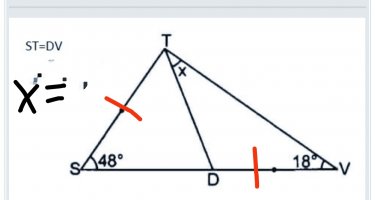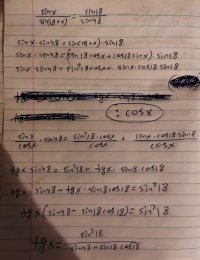You are using an out of date browser. It may not display this or other websites correctly.
You should upgrade or use an alternative browser.
You should upgrade or use an alternative browser.
Help me
- Thread starter tato1982
- Start date
The Highlander
Full Member
- Joined
- Feb 18, 2022
- Messages
- 937
Indeed, there's nothing in your analysis to suggest that ST=DT!∆SDT
ST/sin<sdt=TD/sin48
∆TDV
TD/sin18=DV/sinx
ST/TD=sin48/sin<std
DV/TD=sinx/sin18
ST=TD
sin<std= x+18
sin48/sin(x+18)=sinx/sin18
find trigonometry?????
Also: ST/TD≠sin48/sin<std! You have not re-arranged your initial statement correctly!
∆SDT
ST/sin<sdt=TD/sin48
∆TDV
TD/sin18=DV/sinx
ST/TD=sin48/sin<std
DV/TD=sinx/sin18
ST=DV
Indeed, there's nothing in your analysis to suggest that ST=DT!
Also: ST/TD≠sin48/sin<std! You have not re-arranged your initial statement correctly!Indeed, there's nothing in your analysis to suggest that ST=DT!
Also: ST/TD≠sin48/sin<std! You have not re-arranged your initial statement correctly!∆SDT
ST/sin<sdt=TD/sin48
∆TDV
TD/sin18=DV/sinx
ST/TD=sin48/sin<std
DV/TD=sinx/sin18
ST=DV
sin<std= x+18
sin48/sin(x+18)=sinx/sin18
find trigonometry?????
sin<std= x+18
sin48/sin(x+18)=sinx/sin18
find trigonometry?????
I mistyped it from the beginning or it is correct now so ST = DVIndeed, there's nothing in your analysis to suggest that ST=DT!
Also: ST/TD≠sin48/sin<std! You have not re-arranged your initial statement correctly!
Dr.Peterson
Elite Member
- Joined
- Nov 12, 2017
- Messages
- 16,092
You are now saying this, right?
That is correct.
Now expand sin(x+18) using the angle sum identity, and see what you can do from there. I used some double angle identities later.
sin48/sin(x+18)=sinx/sin18
That is correct.
Now expand sin(x+18) using the angle sum identity, and see what you can do from there. I used some double angle identities later.
I had an error in the condition from the beginning. Now I have corrected it or given that ST = DV
I simplified it and got it tagx = sin ^ 2 18 ° / sin48 ° -sin18 ° cos18 ° After that I could not simplify and I could not find the right side which is equal to
Maybe you can help me how to simplify the right side I could not simplify anything. I used a lot of trigonometric formulas but I could not figure out anything
I simplified it and got it tagx = sin ^ 2 18 ° / sin48 ° -sin18 ° cos18 ° After that I could not simplify and I could not find the right side which is equal to
Maybe you can help me how to simplify the right side I could not simplify anything. I used a lot of trigonometric formulas but I could not figure out anything
Dr.Peterson
Elite Member
- Joined
- Nov 12, 2017
- Messages
- 16,092
So now you are finally saying the two problems are related? Why didn't you say that from the start? You are not making anything easy for us.I simplified it and got it tagx = sin ^ 2 18 ° / sin48 ° -sin18 ° cos18 ° After that I could not simplify and I could not find the right side which is equal to
Please show how you obtained your equation. (From a construction of the triangle, I see that the solution to that equation is correct, though it is not what I got previously for this problem.)
Let's stick with this thread, now that the ideas have come together. Show me something you have tried to solve this equation, so we can talk about it.
Last edited:
Cubist
Senior Member
- Joined
- Oct 29, 2019
- Messages
- 1,667
To get from the triangle image to the first line of the work in post#13 it's possible that @tato1982 did something like this (since this is how I started ? )...

Use sine rule in △TSD
[math]\frac{\sin(18+x)}{1} = \frac{\sin(48)}{TD} \implies TD = \frac{\sin(48)}{\sin(18+x)}[/math]
Use sine rule in △TDV
[math]\frac{\sin(18)}{TD} = \frac{\sin(x)}{1} \implies \frac{\sin(18)}{\sin(x)} = TD[/math]
Equate the two "TD" above...
[math]\frac{\sin(48)}{\sin(18+x)} = \frac{\sin(18)}{\sin(x)}[/math][math]\frac{\sin(x)}{\sin(18+x)} = \frac{\sin(18)}{\sin(48)}[/math]

Use sine rule in △TSD
[math]\frac{\sin(18+x)}{1} = \frac{\sin(48)}{TD} \implies TD = \frac{\sin(48)}{\sin(18+x)}[/math]
Use sine rule in △TDV
[math]\frac{\sin(18)}{TD} = \frac{\sin(x)}{1} \implies \frac{\sin(18)}{\sin(x)} = TD[/math]
Equate the two "TD" above...
[math]\frac{\sin(48)}{\sin(18+x)} = \frac{\sin(18)}{\sin(x)}[/math][math]\frac{\sin(x)}{\sin(18+x)} = \frac{\sin(18)}{\sin(48)}[/math]
I got that too but in the end I could not solve the equationTo get from the triangle image to the first line of the work in post#13 it's possible that @tato1982 did something like this (since this is how I started ? )...
View attachment 31211
Use sine rule in △TSD
[math]\frac{\sin(18+x)}{1} = \frac{\sin(48)}{TD} \implies TD = \frac{\sin(48)}{\sin(18+x)}[/math]
Use sine rule in △TDV
[math]\frac{\sin(18)}{TD} = \frac{\sin(x)}{1} \implies \frac{\sin(18)}{\sin(x)} = TD[/math]
Equate the two "TD" above...
[math]\frac{\sin(48)}{\sin(18+x)} = \frac{\sin(18)}{\sin(x)}[/math][math]\frac{\sin(x)}{\sin(18+x)} = \frac{\sin(18)}{\sin(48)}[/math]
Dr.Peterson
Elite Member
- Joined
- Nov 12, 2017
- Messages
- 16,092
We still want to see what you have tried in order to solve the equation.I got that too but in the end I could not solve the equation
I have tried, and I suspect it is very specific to the angles involved, so that no general identity will help much. What you may need to do is to recognize that the solution is 12 degrees, and attempt to show that that is a solution of your equation by finding the exact value of the trig functions involved, and demonstrating that sin(12)sin(48) = sin(18)sin(30). I find even that rather difficult.
But also, you haven't yet told us the context of the problem, and that is something we ask in order to direct our thinking. If the instructions told you to find the exact solution, that is one thing; if you just saw that a calculator tells you that the answer appears to be exactly 12 and you just want to show that it is indeed exact, that is another issue. (Sometimes the latter can be difficult, as we are finding here.) You HAVE solved the problem! You just want to do it in a nicer way, which may not even exist.
Your position is clear, I just spend the nights and I could not get an answer without a calculatorWe still want to see what you have tried in order to solve the equation.
I have tried, and I suspect it is very specific to the angles involved, so that no general identity will help much. What you may need to do is to recognize that the solution is 12 degrees, and attempt to show that that is a solution of your equation by finding the exact value of the trig functions involved, and demonstrating that sin(12)sin(48) = sin(18)sin(30). I find even that rather difficult.
But also, you haven't yet told us the context of the problem, and that is something we ask in order to direct our thinking. If the instructions told you to find the exact solution, that is one thing; if you just saw that a calculator tells you that the answer appears to be exactly 12 and you just want to show that it is indeed exact, that is another issue. (Sometimes the latter can be difficult, as we are finding here.) You HAVE solved the problem! You just want to do it in a nicer way, which may not even exist.
We still want to see what you have tried in order to solve the equation.
I have tried, and I suspect it is very specific to the angles involved, so that no general identity will help much. What you may need to do is to recognize that the solution is 12 degrees, and attempt to show that that is a solution of your equation by finding the exact value of the trig functions involved, and demonstrating that sin(12)sin(48) = sin(18)sin(30). I find even that rather difficult.
But also, you haven't yet told us the context of the problem, and that is something we ask in order to direct our thinking. If the instructions told you to find the exact solution, that is one thing; if you just saw that a calculator tells you that the answer appears to be exactly 12 and you just want to show that it is indeed exact, that is another issue. (Sometimes the latter can be difficult, as we are finding here.) You HAVE solved the problem! You just want to do it in a nicer way, which may not even exist.
Cubist
Senior Member
- Joined
- Oct 29, 2019
- Messages
- 1,667
I have not proved an exact result yet. But I have a strategy in mind...
ON RHS change sin(48) into sin(30+18) and then split into sin & cos with parameters 30 or 18
ON LHS make the substitution x = a-b, so instead of tan(x) we have tan(a-b) and then split into sin & cos with parameters a or b
PERHAPS it will be possible to prove that a=30 and b=18 by comparison of LHS and RHS
ON RHS change sin(48) into sin(30+18) and then split into sin & cos with parameters 30 or 18
ON LHS make the substitution x = a-b, so instead of tan(x) we have tan(a-b) and then split into sin & cos with parameters a or b
PERHAPS it will be possible to prove that a=30 and b=18 by comparison of LHS and RHS
I will see an interesting strategy nowI have not proved an exact result yet. But I have a strategy in mind...
ON RHS change sin(48) into sin(30+18) and then split into sin & cos with parameters 30 or 18
ON LHS make the substitution x = a-b, so instead of tan(x) we have tan(a-b) and then split into sin & cos with parameters a or b
PERHAPS it will be possible to prove that a=30 and b=18 by comparison of LHS and RHS
Cubist
Senior Member
- Joined
- Oct 29, 2019
- Messages
- 1,667
I haven't managed to obtain a proof using the method I suggested.PERHAPS it will be possible to prove that a=30 and b=18 by comparison of LHS and RHS
Look at the following exact values.
sin(18°) = 1/(sqrt(5) + 1)
cos(18°) =sqrt( 10 +2*sqrt(5) )/4
The nested square root (in bold) makes me think that an exact proof would be very difficult to obtain. I agree with post#16.
BigBeachBanana
Senior Member
- Joined
- Nov 19, 2021
- Messages
- 2,181
Perhaps it's easier to work with, in radians.I haven't managed to obtain a proof using the method I suggested.
Look at the following exact values.
sin(18°) = 1/(sqrt(5) + 1)
cos(18°) =sqrt( 10 +2*sqrt(5) )/4
The nested square root (in bold) makes me think that an exact proof would be very difficult to obtain. I agree with post#16.
[math]12\degree=\frac{\pi}{15}\\ 18\degree=\frac{\pi}{10}\\ 30\degree=\frac{\pi}{6}\\ 48\degree=\frac{4\pi}{15}\\[/math]Another observation 12,18,30,48 are all multiple of 6. Maybe this will be useful. ¯\_(ツ)_/¯


